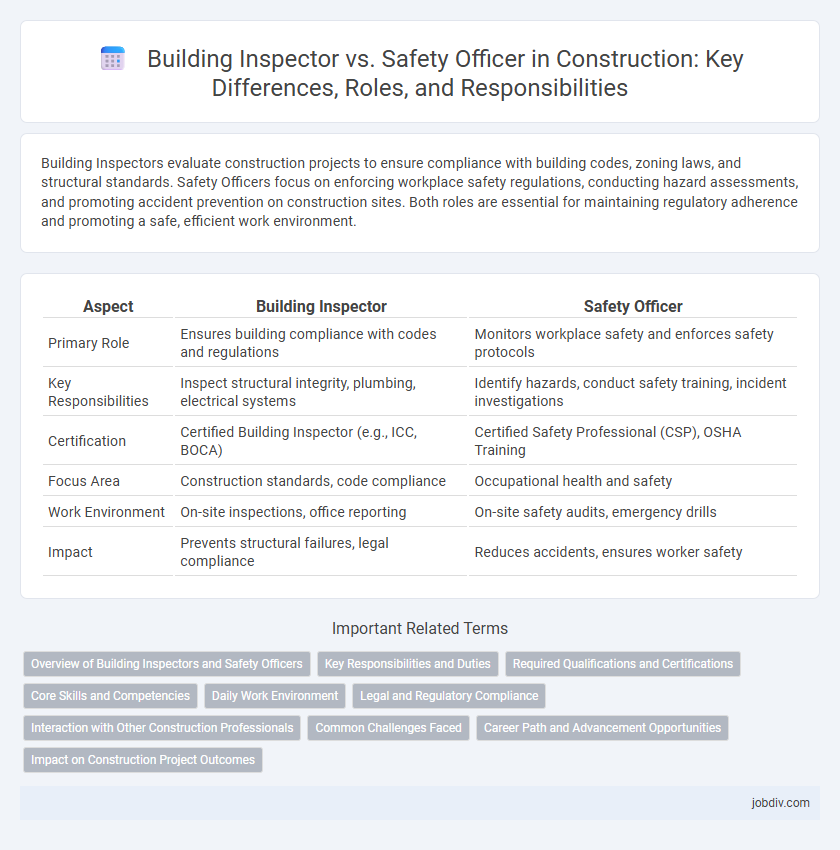Building Inspectors evaluate construction projects to ensure compliance with building codes, zoning laws, and structural standards. Safety Officers focus on enforcing workplace safety regulations, conducting hazard assessments, and promoting accident prevention on construction sites. Both roles are essential for maintaining regulatory adherence and promoting a safe, efficient work environment.
Table of Comparison
| Aspect | Building Inspector | Safety Officer |
|---|---|---|
| Primary Role | Ensures building compliance with codes and regulations | Monitors workplace safety and enforces safety protocols |
| Key Responsibilities | Inspect structural integrity, plumbing, electrical systems | Identify hazards, conduct safety training, incident investigations |
| Certification | Certified Building Inspector (e.g., ICC, BOCA) | Certified Safety Professional (CSP), OSHA Training |
| Focus Area | Construction standards, code compliance | Occupational health and safety |
| Work Environment | On-site inspections, office reporting | On-site safety audits, emergency drills |
| Impact | Prevents structural failures, legal compliance | Reduces accidents, ensures worker safety |
Overview of Building Inspectors and Safety Officers
Building inspectors evaluate construction projects to ensure compliance with local building codes, zoning laws, and safety regulations, conducting on-site examinations and reviewing architectural plans. Safety officers focus on implementing and enforcing workplace safety standards, identifying potential hazards, and promoting safe practices to prevent accidents and injuries on construction sites. Both roles are critical for maintaining legal standards and ensuring the structural integrity and safety of buildings throughout the construction process.
Key Responsibilities and Duties
Building Inspectors conduct thorough examinations of construction sites to ensure compliance with building codes, zoning laws, and structural standards, focusing on the integrity and safety of permanent structures. Safety Officers develop, implement, and monitor workplace safety programs, enforce OSHA regulations, and conduct risk assessments to prevent accidents and injuries on-site. While Building Inspectors prioritize code adherence and structural soundness, Safety Officers emphasize hazard identification and the promotion of safe working environments for construction personnel.
Required Qualifications and Certifications
Building Inspectors must possess a deep understanding of local building codes, typically requiring certifications such as ICC (International Code Council) certification and a relevant degree in construction management or civil engineering. Safety Officers are mandated to hold certifications like OSHA (Occupational Safety and Health Administration) training and often a background in occupational health and safety or industrial hygiene to ensure compliance with workplace safety regulations. Both roles demand continuous education and adherence to state or national licensing requirements to effectively oversee construction site integrity and worker safety.
Core Skills and Competencies
Building Inspectors excel in knowledge of construction codes, zoning laws, and structural integrity assessments, ensuring compliance with legal and technical standards. Safety Officers specialize in hazard identification, risk management, and the enforcement of occupational safety regulations to prevent workplace accidents. Both roles require strong attention to detail, communication skills, and the ability to conduct thorough site evaluations, but Building Inspectors focus more on code compliance while Safety Officers prioritize employee safety and injury prevention.
Daily Work Environment
Building Inspectors conduct detailed site evaluations to ensure compliance with building codes and regulations, focusing on structural integrity and permit adherence. Safety Officers oversee daily safety protocols, hazard identification, and employee training to minimize workplace accidents and promote health standards. Both roles require close interaction with construction teams but emphasize different regulatory and safety priorities within the dynamic construction environment.
Legal and Regulatory Compliance
Building inspectors enforce local building codes and regulations to ensure construction projects comply with legal standards, conducting detailed inspections at various stages of construction. Safety officers focus on implementing workplace safety protocols in accordance with occupational health and safety laws, minimizing risks and preventing accidents on construction sites. Both roles are critical for regulatory compliance, with building inspectors addressing structural integrity and safety officers managing hazard prevention and employee welfare.
Interaction with Other Construction Professionals
Building Inspectors coordinate closely with architects and engineers to ensure compliance with design specifications and regulatory codes during project assessments. Safety Officers collaborate with site supervisors and labor crews to implement hazard controls and enforce safety protocols on daily operations. Both roles require effective communication with contractors and project managers to maintain construction quality and workplace safety standards.
Common Challenges Faced
Building Inspectors and Safety Officers frequently encounter challenges related to regulatory compliance, such as navigating evolving building codes and safety standards. Both roles must address communication gaps between contractors, site workers, and management to ensure hazard identification and risk mitigation. Limited resources and time constraints often hinder thorough inspections and effective enforcement of safety protocols on construction sites.
Career Path and Advancement Opportunities
Building inspectors typically follow a career path that involves gaining experience in construction or engineering, obtaining relevant certifications like ICC (International Code Council) certifications, and advancing to senior inspection roles or management positions within municipal or private sectors. Safety officers often start with a background in occupational health and safety, earning certifications such as OSHA (Occupational Safety and Health Administration) or NEBOSH, and progress into roles like safety managers, compliance directors, or corporate safety consultants. While building inspectors focus on regulatory compliance and structural integrity, safety officers specialize in workplace hazard prevention and risk management, offering distinct but complementary advancement opportunities in the construction industry.
Impact on Construction Project Outcomes
Building Inspectors ensure compliance with building codes and regulations, directly affecting project quality and legal adherence, which reduces the risk of costly rework and project delays. Safety Officers focus on maintaining site safety standards, minimizing workplace accidents and associated downtime, which improves workforce productivity and project timelines. Both roles collaboratively support efficient construction project outcomes by safeguarding structural integrity and worker safety, essential for timely and successful project completion.
Building Inspector vs Safety Officer Infographic

 jobdiv.com
jobdiv.com